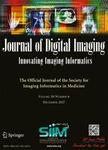版权所有:内蒙古大学图书馆 技术提供:维普资讯• 智图
内蒙古自治区呼和浩特市赛罕区大学西街235号 邮编: 010021

作者机构:Mayo Med Ctr Dept Diagnost Radiol & Syst & Procedures Rochester MN 55905 USA
出 版 物:《JOURNAL OF DIGITAL IMAGING》 (J Digital Imaging)
年 卷 期:1999年第12卷第2期
页 面:32-36页
核心收录:
学科分类:1001[医学-基础医学(可授医学、理学学位)] 1009[医学-特种医学] 10[医学]
主 题:Image communication systems
摘 要:Electronic imaging clinical implementation strategies and principles need to be developed as we move toward replacement of film-based radiology practices. During an 8-month period (1998 to 1999), an Electronic Imaging Clinical Implementation Work Group (EICIWG) was formed from sections of our department: Informatics Lab, Finance Committee, Management Section, Regional Practice Group, as well as several organ and image modality sections of the Department of Diagnostic Radiology. This group was formed to study and implement policies and strategies regarding implementation of electronic imaging into our practice. The following clinical practice issues were identified as key focus areas: (1) optimal electronic worklist organization;(2) how and when to link images with reports;(3) how to redistribute technical and professional relative value units (RVU);(4) how to facilitate future practice changes within our department regarding physical location and work redistribution;and (5) how to integrate off-campus imaging into on-campus work-flow. The EICIWG divided their efforts into two phases. Phase I consisted of Fact finding and review of current practice patterns and current economic models, as well as radiology consulting needs. Phase II involved the development of recommendations, policies, and strategies for reengineering the radiology department to maintain current practice goals and use electronic imaging to improve practice patterns. The EICIWG concluded that electronic images should only be released with a formal report, except in emergent situations. Electronic worklists should support and maintain the physical presence of radiologists in critical areas and direct imaging to targeted subspecialists when possible. Case tools should be developed and used in radiology and hospital information systems (RIS/HIS) to monitor a number of parameters, including professional and technical RVU data. As communication standards improve, proper staffing models must be developed t